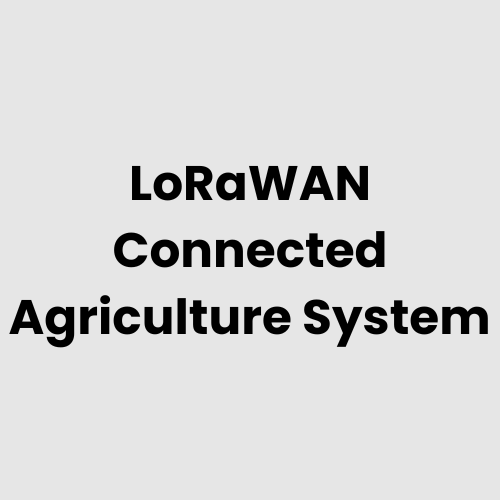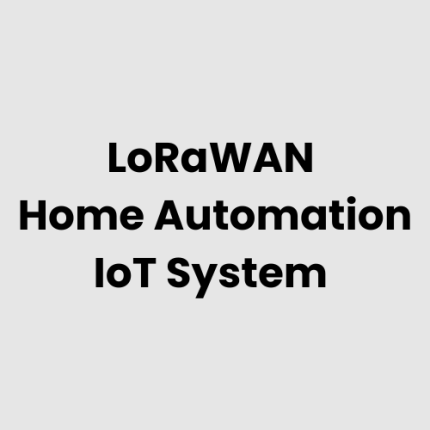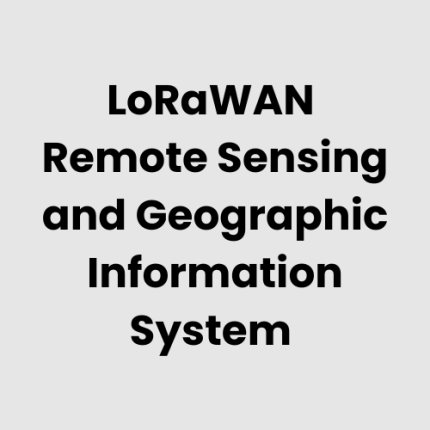Description
Technical Architecture of LoRaWAN Enabled Connected Agriculture System
The LoRaWAN Enabled Connected Agriculture System is a comprehensive solution designed to monitor and manage agricultural environments using long-range, low-power wireless communication. The system utilizes LoRaWAN-enabled devices, sensors, and gateways to gather data in real-time, which is then transmitted to centralized platforms for analysis and decision-making.
The system architecture consists of the following key components:
- IoT Sensors: Deployed across the agricultural fields to monitor various parameters, including soil moisture, temperature, humidity, and crop health.
- LoRaWAN Gateways: These gateways facilitate the transmission of data from IoT sensors to cloud or local servers.
- Cloud or Local Server: Data is either processed or stored in the cloud or via an on premise local server, depending on deployment preferences.
- Data Analytics Platform: This platform analyses the sensor data to provide actionable insights, which are then used for decision-making in farming practices.
- User Interface: A web or mobile application that allows farmers and agricultural managers to access and visualize the data in real time.
List of Hardware for LoRaWAN Enabled Connected Agriculture System
- Soil Moisture Sensors
- Temperature and Humidity Sensors
- Weather Stations
- LoRaWAN Gateways
- LoRaWAN Sensors (Air Quality, Crop Health)
- Solar Power Units (for remote areas)
- Edge Devices (for on-site data aggregation)
- Data Analytics Servers (Cloud or Local)
- Mobile and Desktop Applications (for data visualization and monitoring)
Physical Placement Considerations for LoRaWAN Enabled Connected Agriculture System
- Sensor Placement: Sensors should be strategically placed in the soil, on crops, and around irrigation systems to collect data on moisture levels, temperature, and other environmental factors.
- Gateway Location: LoRaWAN gateways should be positioned in open areas with minimal obstructions to ensure maximum coverage of remote areas and field sites.
- Power Sources: Solar power units are commonly used to provide energy to remote sensors and devices, ensuring continuous operation.
- Data Transmission: Gateways should be located within a reasonable range of sensors to maintain robust communication, typically no more than a few kilometres, depending on the terrain.
Hardware Architecture of LoRaWAN Enabled Connected Agriculture System
- Sensors: Deployed across the field, each sensor gathers specific data such as soil moisture, temperature, and humidity.
- LoRaWAN Gateways: These devices collect and forward the sensor data to centralized systems, either on the cloud or local servers.
- Data Analytics and Storage: Data is processed in real time on local or cloud-based servers, providing insights into agricultural conditions.
- User Interface: Farmers can access the data through apps or desktop platforms, allowing them to make informed decisions based on the analysis.
Deployment Considerations for LoRaWAN Enabled Connected Agriculture System
- Infrastructure Setup: Ensure that sensors are placed in optimal locations for maximum coverage. LoRaWAN gateways should be strategically positioned to cover all sensor nodes across large farming areas.
- Power Management: For remote agricultural sites, solar-powered devices are recommended for uninterrupted system operation.
- Data Connectivity: Depending on the geographical location, ensure that either cloud or local server solutions are deployed for data processing, keeping in mind network accessibility.
- System Calibration: Sensors should be calibrated based on regional climate and soil conditions to ensure accurate data collection.
List of Relevant Industry Standards and Regulations
- LoRaWAN Network Specification (LoRa Alliance)
- ISO 9001:2015 Quality Management Systems
- ISO/IEC 27001:2013 Information Security Management Systems
- National Agricultural Safety Database (NASD) Guidelines
- IEEE 802.15.4 (Standard for Low-Rate Wireless Personal Area Networks)
- FCC Part 15 (Radio Frequency Device Regulations in the U.S.)
- The European Union’s General Data Protection Regulation (GDPR)
- ISO 14001 (Environmental Management)
Local Server Version: Running with a Local Server
For certain agricultural operations, a local server version of the LoRaWAN Enabled Connected Agriculture System can be deployed. In this setup:
- Data Storage and Analysis: All sensor data is collected by the gateways and transmitted directly to local servers.
- Security: Since data is stored on-site, additional security measures, including physical security and internal access controls, need to be implemented.
- Processing: Data is processed and analysed locally, allowing for quick decision-making without the reliance on external cloud services.
Cloud Integration and Data Management
Cloud integration is a vital component of the LoRaWAN Enabled Connected Agriculture System. By leveraging cloud platforms:
- Real-Time Data Access: Farmers and managers can access the system remotely, receiving real-time updates from any location via web or mobile apps.
- Data Storage: The cloud provides virtually unlimited storage capacity for long-term agricultural data.
- Advanced Analytics: Cloud systems enable the use of advanced data analysis, including AI and machine learning algorithms, to predict crop yields, optimize irrigation, and monitor plant health.
- Scalability: As the agricultural system grows, cloud infrastructure allows for seamless scaling without additional on-site hardware.
GAO Case Studies of LoRaWAN Enabled Connected Agriculture System
USA Case Studies
- California
A large vineyard in Napa Valley implemented a LoRaWAN-enabled connected agriculture system to monitor soil moisture and weather conditions. The system helped optimize irrigation schedules, improving water usage efficiency and increasing crop yields while minimizing water waste. - Texas
A cotton farm in Lubbock used LoRaWAN technology to monitor soil temperature and humidity levels. The system allowed for better pest control and early detection of plant diseases, leading to a healthier crop yield and reduced pesticide use. - Florida
A citrus grove in Orlando deployed LoRaWAN-based sensors to track soil moisture, temperature, and leaf wetness. This enabled precise irrigation control, reducing water usage and preventing over-watering, which has been a key factor in maintaining fruit quality. - Washington
In the Columbia River Basin, a potato farm implemented a LoRaWAN system to collect real-time environmental data. The system helped predict optimal harvest times and provided insights into soil health, resulting in higher yields and reduced resource usage. - Georgia
A blueberry farm in Atlanta used a LoRaWAN-enabled system to monitor crop health and soil conditions. The data collected from the farm’s sensors allowed for better management of irrigation and nutrient delivery, enhancing crop productivity. - Colorado
A large-scale cattle ranch in Denver adopted a LoRaWAN system for livestock tracking. Sensors monitored animal health and environmental conditions, helping ranchers optimize feed delivery and reduce stress-related illnesses among cattle. - Arizona
A desert farming operation in Phoenix integrated LoRaWAN technology to measure soil salinity and moisture levels. The system helped the farmers adjust irrigation techniques and improve crop productivity in the region’s challenging conditions. - Illinois
A corn farm in Chicago implemented LoRaWAN sensors for continuous monitoring of crop moisture and weather conditions. The system enhanced the timing of irrigation cycles, leading to better soil moisture retention and improved corn yields. - Michigan
A dairy farm in Grand Rapids used LoRaWAN technology to monitor air quality and environmental conditions in barns. This helped optimize conditions for livestock, increasing milk production while reducing animal health issues related to poor air quality. - New York
An apple orchard in upstate New York deployed LoRaWAN-enabled environmental monitoring to track temperature fluctuations and humidity. This improved the management of frost risks, preserving the health of the apple trees and minimizing crop loss. - Ohio
A soybean farm in Columbus used LoRaWAN sensors to track nitrogen levels in the soil, optimizing fertilizer application. The system improved crop yield while significantly reducing fertilizer costs and environmental impact. - Nebraska
A wheat farm in Omaha utilized LoRaWAN technology to monitor soil conditions and weather data. The system provided critical insights that helped the farm schedule irrigation more efficiently and enhance the overall health of the crops. - North Carolina
A tobacco farm in Raleigh implemented LoRaWAN-based sensors to track humidity and soil moisture. This allowed the farm to manage irrigation schedules better, improving crop quality and reducing water consumption. - Kansas
A sunflower farm in Topeka deployed a LoRaWAN system to track environmental parameters, including temperature and light intensity. The system provided real-time data that improved growth predictions and harvest planning, boosting yield efficiency. - South Dakota
A corn and soybean operation in Sioux Falls adopted a LoRaWAN system to measure soil moisture content. This helped optimize irrigation and reduce water usage while ensuring crops received the optimal amount of water for growth.
Canada Case Studies
- Ontario
A maple syrup producer in Toronto used LoRaWAN-enabled sensors to monitor temperature variations, essential for sap collection. This system provided accurate readings that allowed for precise collection times, ensuring higher sap yields and better syrup quality. - Alberta
A large cattle ranch in Calgary deployed LoRaWAN sensors to track herd health and environmental conditions. The system improved management of feed and water supply, helping maintain optimal conditions for livestock and boosting overall production efficiency.
Navigation Menu for LoRaWAN
Navigation Menu for IoT
- LORAWAN
- ZIGBEE
- Wi-Fi HaLow
- Z-WAVE
- BLE & RFID
- NB-IOT
- CELLULAR IOT
- GPS IOT
- IOT SENSORS
- EDGE COMPUTING
- IOT SYSTEMS
Our products are in stock and can be shipped anywhere in the continental U.S. or Canada from our local warehouse. For any further information, please fill out this form or email us.
We are actively looking for partners who are like us located in the U.S. and Canada. For more information on partnering with GAO, please visit Partner with GAO Tek Inc. It lists various ways to partner with GAO, such as OEM Partnerships, Technology Integration, Distribution and Reselling Opportunities, Presenting at the Leading Event Tek Summit, Joint R&D Projects, Training and Consulting Services, Industry-Specific Collaborations, Research and Academic Partnerships.



